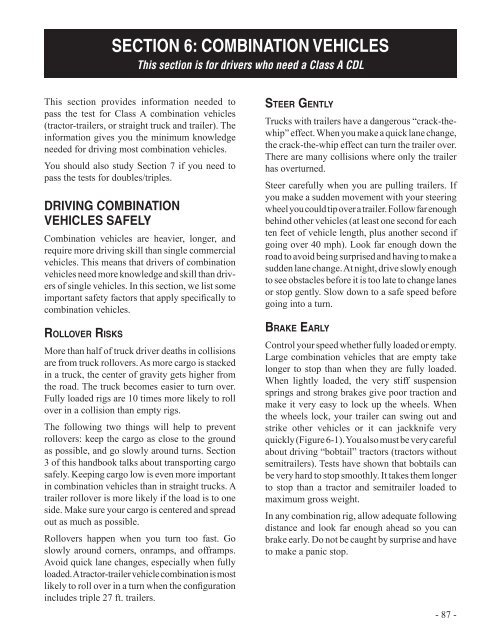Commercial Driver Handbook ( PDF ) - California Department of ...
Commercial Driver Handbook ( PDF ) - California Department of ...
Commercial Driver Handbook ( PDF ) - California Department of ...
You also want an ePaper? Increase the reach of your titles
YUMPU automatically turns print PDFs into web optimized ePapers that Google loves.
This section provides information needed to<br />
pass the test for Class A combination vehicles<br />
(tractor-trailers, or straight truck and trailer). The<br />
information gives you the minimum knowledge<br />
needed for driving most combination vehicles.<br />
You should also study Section 7 if you need to<br />
pass the tests for doubles/triples.<br />
DRIVIng cOmBInAtIOn<br />
VehIcleS SAFely<br />
Combination vehicles are heavier, longer, and<br />
require more driving skill than single commercial<br />
vehicles. This means that drivers <strong>of</strong> combination<br />
vehicles need more knowledge and skill than drivers<br />
<strong>of</strong> single vehicles. In this section, we list some<br />
important safety factors that apply specifically to<br />
combination vehicles.<br />
rollover risks<br />
SectIOn 6: cOmBInAtIOn VehIcleS<br />
This section is for drivers who need a Class A CDL<br />
More than half <strong>of</strong> truck driver deaths in collisions<br />
are from truck rollovers. As more cargo is stacked<br />
in a truck, the center <strong>of</strong> gravity gets higher from<br />
the road. The truck becomes easier to turn over.<br />
Fully loaded rigs are 10 times more likely to roll<br />
over in a collision than empty rigs.<br />
The following two things will help to prevent<br />
rollovers: keep the cargo as close to the ground<br />
as possible, and go slowly around turns. Section<br />
3 <strong>of</strong> this handbook talks about transporting cargo<br />
safely. Keeping cargo low is even more important<br />
in combination vehicles than in straight trucks. A<br />
trailer rollover is more likely if the load is to one<br />
side. Make sure your cargo is centered and spread<br />
out as much as possible.<br />
Rollovers happen when you turn too fast. Go<br />
slowly around corners, onramps, and <strong>of</strong>framps.<br />
Avoid quick lane changes, especially when fully<br />
loaded. A tractor-trailer vehicle combination is most<br />
likely to roll over in a turn when the configuration<br />
includes triple 27 ft. trailers.<br />
steer gently<br />
Trucks with trailers have a dangerous “crack-thewhip”<br />
effect. When you make a quick lane change,<br />
the crack-the-whip effect can turn the trailer over.<br />
There are many collisions where only the trailer<br />
has overturned.<br />
Steer carefully when you are pulling trailers. If<br />
you make a sudden movement with your steering<br />
wheel you could tip over a trailer. Follow far enough<br />
behind other vehicles (at least one second for each<br />
ten feet <strong>of</strong> vehicle length, plus another second if<br />
going over 40 mph). Look far enough down the<br />
road to avoid being surprised and having to make a<br />
sudden lane change. At night, drive slowly enough<br />
to see obstacles before it is too late to change lanes<br />
or stop gently. Slow down to a safe speed before<br />
going into a turn.<br />
Brake early<br />
Control your speed whether fully loaded or empty.<br />
Large combination vehicles that are empty take<br />
longer to stop than when they are fully loaded.<br />
When lightly loaded, the very stiff suspension<br />
springs and strong brakes give poor traction and<br />
make it very easy to lock up the wheels. When<br />
the wheels lock, your trailer can swing out and<br />
strike other vehicles or it can jackknife very<br />
quickly (Figure 6-1). You also must be very careful<br />
about driving “bobtail” tractors (tractors without<br />
semitrailers). Tests have shown that bobtails can<br />
be very hard to stop smoothly. It takes them longer<br />
to stop than a tractor and semitrailer loaded to<br />
maximum gross weight.<br />
In any combination rig, allow adequate following<br />
distance and look far enough ahead so you can<br />
brake early. Do not be caught by surprise and have<br />
to make a panic stop.<br />
- 87 -

















